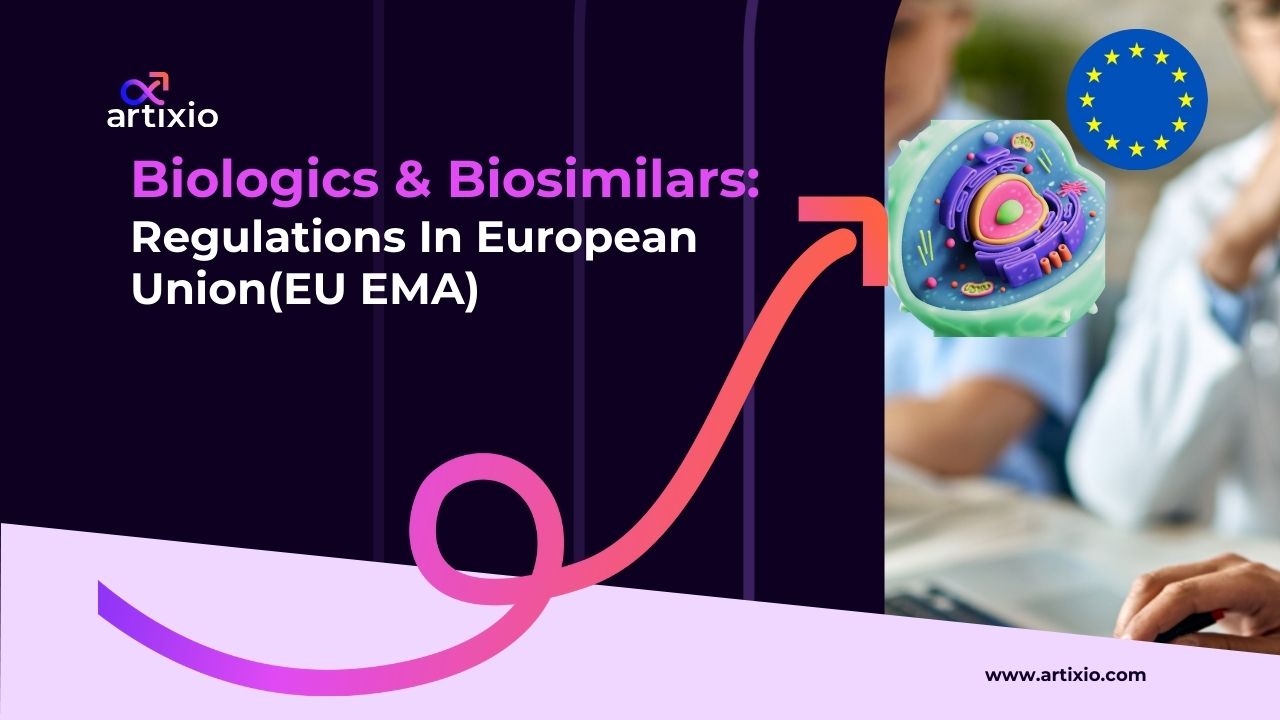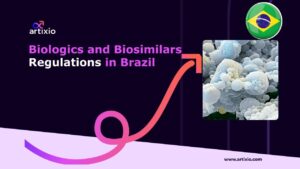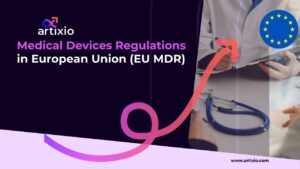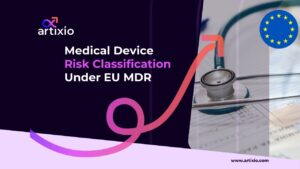In 2022, the Europe biosimilar market had a value of almost USD 4601.56 million. In addition, it is anticipated that the biosimilar market will expand at a CAGR of 25% between 2021 and 2026, reaching a value of over USD 17553.59 million by 2028.
The increased incidence of autoimmune disorders and diabetes, the low cost of biosimilars, and the growing elderly population are the main market drivers.
The biosimilars market in the EU has been gradually expanding, driven by the introduction of biosimilar versions of established biologic products. Biosimilars have been developed for a range of therapeutic areas, including oncology, autoimmune diseases, and more. As patents for original biologics have expired, biosimilar competition has increased, offering more affordable treatment options.
This article outlines the Biologics and Biosimilar regulation and registration in European Union (EU) (EMA)
Biologics & Biosimilar Regulations in European Union
Biologics are complex, large-molecule drugs that are typically derived from living organisms or cells. They include a wide range of therapeutic products, such as monoclonal antibodies, vaccines, and gene therapies. Biologics are often used to treat conditions like cancer, autoimmune diseases, and rare genetic disorders.
Examples of biologics: Adalimumab (Humira), Trastuzumab (Herceptin), Erythropoietin (EPO), Insulin glargine (Lantus)
Biosimilars are biological medicinal products that are highly similar to an approved reference biologic (also known as an innovator or originator biologic). They have no clinically meaningful differences in terms of safety, quality, and efficacy from the reference biologic. Biosimilars are developed to be cost-effective alternatives to their reference products.
Examples of biosimilars:
- Infliximab biosimilars: Used to treat autoimmune diseases like rheumatoid arthritis, Crohn’s disease, and psoriasis.
- Filgrastim biosimilars: Used to stimulate the production of white blood cells in patients undergoing chemotherapy.
- Epoetin biosimilars: Used to treat anemia caused by chronic kidney disease or chemotherapy.
- Rituximab biosimilars: Used to treat non-Hodgkin’s lymphoma, chronic lymphocytic leukemia, and rheumatoid arthritis.
Centralized Approval Process:
The European Medicines Agency (EMA) is responsible for regulating and approving medicinal products, including biologics and biosimilars, in the EU. The centralized approval process allows for a single application that, if approved, grants market access across all EU member states.
Regulatory Pathway in European Union:
The regulatory pathway for biosimilars in the EU involves demonstrating a thorough comparability exercise between the biosimilar and the reference biologic. This includes extensive analytical, functional, and clinical studies to establish similarity in terms of quality, safety, and efficacy.
Step 1: Preparation and Planning:
Scientific Advice: Developers can seek scientific advice from the EMA early in the development process to receive guidance on regulatory requirements, study designs, and data expectations.
Step 2: Documents Preparation
Quality Documentation:
- Chemistry, Manufacturing, and Control (CMC) Data: Detailed information about the manufacturing process, quality control, and specifications for the biosimilar or biologic product.
- Comparability Studies: Data demonstrating that the biosimilar is highly similar to the reference biologic in terms of quality attributes.
- Stability Data: Information on the stability of the product under various storage conditions.
Non-Clinical Documentation:
- Pharmacology and Toxicology Data: Non-clinical studies providing information on the pharmacological activity and safety profile of the biosimilar or biologic.
Clinical Documentation:
- Clinical Trial Protocols: Detailed protocols for clinical trials designed to demonstrate the safety and efficacy of the biosimilar or biologic.
- Clinical Trial Results: Data from clinical trials, including safety and efficacy outcomes, pharmacokinetics, immunogenicity, and any relevant patient-reported outcomes.
- Comparative Clinical Studies: Comparative clinical studies that establish the biosimilar’s similarity to the reference biologic and demonstrate equivalent clinical outcomes.
- Extrapolation Data: Scientific rationale and supporting data for any extrapolation of indications from the reference biologic to the biosimilar.
Pharmacovigilance Documentation:
- Risk Management Plan (RMP): A plan outlining the strategies for monitoring and managing the safety of the biosimilar or biologic throughout its lifecycle.
- Pharmacovigilance System Master File (PSMF): A document providing an overview of the company’s pharmacovigilance system and processes.
Regulatory Documentation:
- Summary of Product Characteristics (SmPC): Comprehensive information for healthcare professionals, including indications, dosing, contraindications, and precautions.
- Package Leaflet: Patient-friendly information about the biosimilar or biologic’s use, risks, and benefits.
Biosimilarity and Analytical Data:
Comparability Exercise: Detailed analytical data comparing the biosimilar to the reference biologic, demonstrating similarity in terms of quality attributes.
Naming and Identification Documentation:
- Proposed Non-Proprietary Name: A unique non-proprietary name for the biosimilar, following the naming conventions specified by the EMA.
- Environmental Risk Assessment (if applicable):
- Information on potential environmental risks associated with the manufacturing and use of the biosimilar or biologic.
Step 3: Submission and Evaluation:
- The company submits the comprehensive set of documents to the EMA through the centralized procedure.
- EMA experts evaluate the data to ensure quality, safety, and efficacy meet regulatory standards.
- Scientific Advice and Interactions: Developers may have interactions with the EMA throughout the process for clarification or additional information.
Step 4: Approval Decision:
If the data demonstrate that the product meets the required standards, the EMA grants a marketing authorization.
Biologics/Biosimilar Registration Applicable Fees in EU:
Typically, it takes about 11 months for obtaining market authorization of biologics and biosimilars.
Extrapolation of Indications: The EU allows for the concept of extrapolation, where a biosimilar can be approved for an indication that was not directly studied in clinical trials if scientific justification is provided and the mechanism of action is well-understood.
Post Marketing Surveillance:
Post-market surveillance (PMS) is a crucial component of ensuring the ongoing safety and efficacy of biologics and biosimilars in the European Union (EU). PMS activities aim to monitor the products’ performance, detect and assess any adverse events or safety issues, and take appropriate regulatory actions if necessary.
Pharmacovigilance System and Traceability: Marketing authorization holders (MAHs) of biologics and biosimilars are required to have a robust pharmacovigilance system in place to monitor and assess the safety of their products post-market.
A Pharmacovigilance System Master File (PSMF) provides an overview of the company’s pharmacovigilance system and processes.
Robust pharmacovigilance systems are in place to monitor the safety of biologics and biosimilars post-market approval. Traceability measures are implemented to track the use of specific products in patients.
Naming and Labeling:
Biosimilars are given unique non-proprietary names with a common stem shared with the reference biologic. This naming approach aims to ensure accurate identification and traceability of products.
Adverse Event Reporting: MAHs are responsible for collecting and reporting adverse events (AEs), including serious and unexpected AEs, to regulatory authorities as part of their pharmacovigilance obligations. Healthcare professionals and patients can also report AEs directly to regulatory authorities through national reporting systems.
Periodic Safety Update Reports (PSURs): MAHs submit PSURs at defined intervals to provide an overview of the product’s safety profile based on post-market data, including any emerging safety concerns.
Signal Detection and Evaluation:
Ongoing signal detection involves systematically reviewing safety data to identify potential safety concerns that may require further investigation.
Safety Referrals and Actions: Regulatory authorities, such as the European Medicines Agency (EMA), can initiate safety referrals and take regulatory actions, including updating product labeling, restricting use, or even suspending or withdrawing a product from the market if significant safety concerns arise.
Real-World Evidence (RWE): Real-world data and evidence collected from routine clinical practice contribute to the ongoing assessment of a product’s safety and effectiveness post-market.
Data Exclusivity and Market Access: Biosimilars benefit from a period of data exclusivity for the reference biologic, during which their application cannot be submitted. Once the data exclusivity period expires, biosimilars can be submitted for approval, which helps to balance innovation and competition.
Switching and Interchangeability: The EU provides guidance on switching between a reference biologic and its biosimilar, with consideration for the specific therapeutic area, patient population, and available data. The concept of interchangeability, which allows for substitution without the involvement of the prescribing healthcare professional, is subject to additional national regulations.
References:
- https://www.ncbi.nlm.nih.gov/pmc/articles/PMC5322938/
- https://www.ema.europa.eu/en/documents/leaflet/biosimilars-eu-information-guide-healthcare-professionals_en.pdf
- https://www.ema.europa.eu/en/human-regulatory/overview/fees-payable-european-medicines-agency
- https://www.ema.europa.eu/en/human-regulatory-overview/marketing-authorisation/biosimilar-medicines-marketing-authorisation





